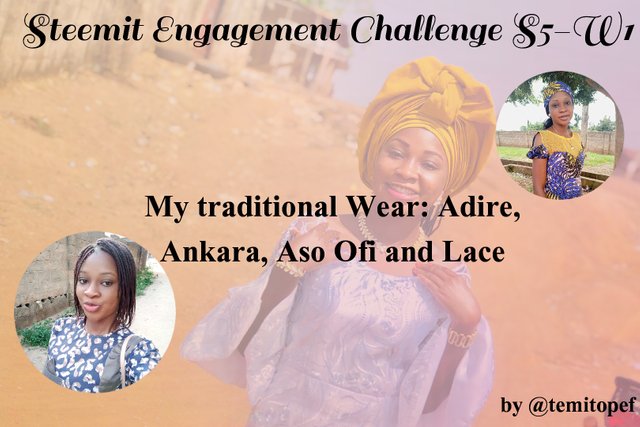
Cover Image Created using Poster Maker
Good day Steemians, I'm so excited to be here and join the contest organized by this community which talks about our native wear. I'm from a Yoruba tribe which are in southwest Nigeria and my tribe is popularly known for our language and our traditional wears. Go with me as I will be sharing with you the native wears of the Yoruba people.
What are your native wear Names? Talk about each of them if many.
My tribe Yoruba has much native wears, some of these dresses originated from us while some were well adopted by our forefathers. The names of our native wears are:
Adire: Adire with the English name, **tie and dye** can be defined as an indigo-dyed cloth that is made by Yoruba women in southwestern Nigeria with the use of resist-dyeing techniques to produce a pattern design in extreme bright ranges of tints and hues.

Stock of Adire on sale, Wikimedia commons image
Adire textiles can be achieved with the use of thread (for tying, folding, or stitching), wax, and dyes on a plain cloth to make a beautiful colored pattern design. It is one of the popular cloth that has been adopted all over the country.
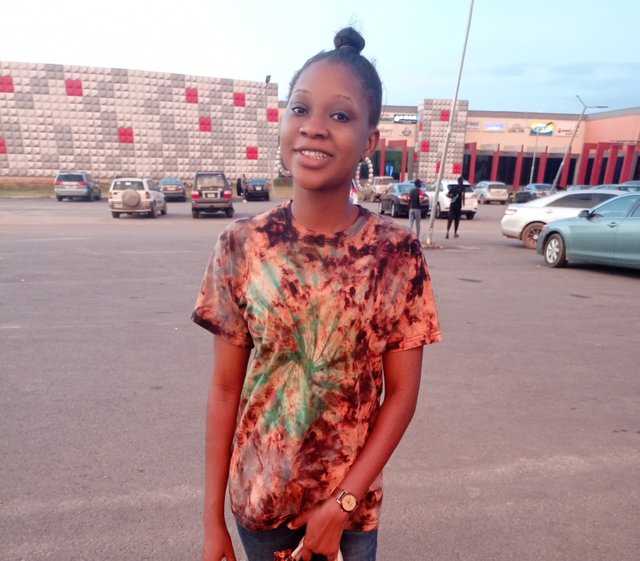
Image of me wearing a plain T-shirt used to make Adire, image taken with my phone
Aside from using new plain fabric in making Adire, faded plain fabric too can be beautified by turning it into Adire. Adire cloth is being used to sow different styles from agbada (men's come down style), Buba and Iro (blouse and wrapper), top, shirt, skirt, and trouser.
Aso Ofi: Aso Ofi popularly called Aso Oke is a cloth made from cotton and handwoven, it is also one of the most popular native wears originated from the Yoruba tribe in a Southwestern towns in Nigeria, Iseyin in Oyo State and Ede in Osun State and is popularly accepted by other tribes in the country.
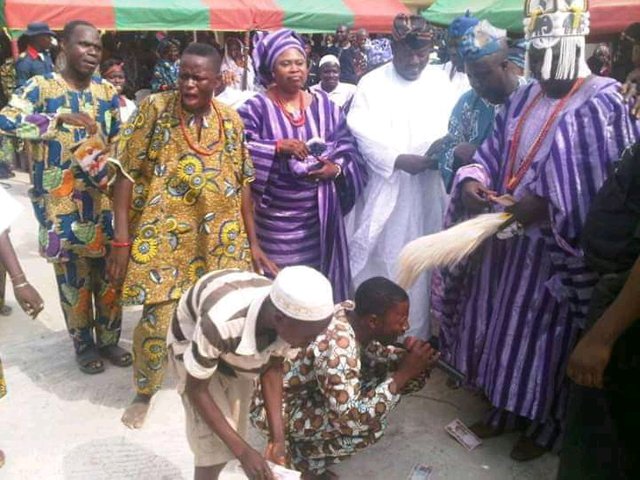
Image of my town king and queen in Complete Aso ofi to our town festival taken from my phone
Aso Ofi is done manually by sorting the raw cotton, or fibers to combing, spinning, and warping, the process is hectic and takes days before it is completely done. Aso Ofi is worn to mark a special occasion like a festival, engagement, traditional wedding, introduction, naming ceremony, anniversary, and so on.
Aso Ofi can be used to sow agbada, trousers, cap, wrapper, Buba (blouse), gele, and ipele (head tie and the piece of cloth placed on the shoulder). My tribe does wear it alone as a complete dress or wears a cap, and head tie made with ofi to compliment our other natives wears like ankara, lace, and adire.
Ankara: Ankara which is also called Dutch wax or African wax is a popular and common clothing material in West and Central Africa, Ankara was introduced to West and Central Africa by a European Dutch merchant and has been popularly accepted since then.
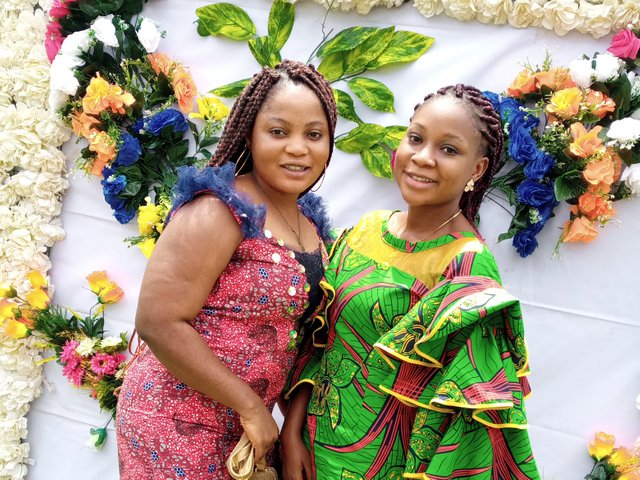
Image of myself and my sister in different Ankara taken from my phone
We wear Ankara here on a normal day and for events, it can be worn alone as a complete dress such as gown, agbada, wrapper and blouse, blouse and skirt and top and trouser, sometimes we wear Ofi cap and a head tie with it for events.
Lace: Lace is seen as a delicate fabric made with a lot of holes in it, it is made of yarn or thread and it is of two categories known as needle lace and bobbin lace. Needle lace is done with the use of a single needle and thread to make stitches which later form lace fabric while bobbin lace makes use of many threads attached to small bobbins to create a pattern.
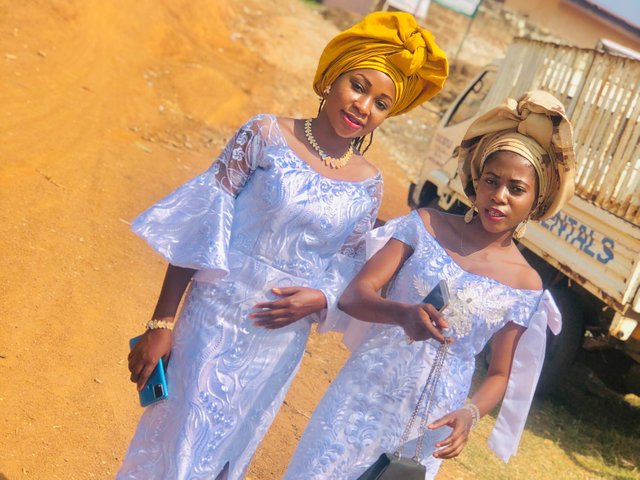
Image of myself and my friend on different designs of lace with aso ofi as head ties taken from my phone
Lace is a popular native wear here in my country and with my tribe, there are many designs of lace and all of it can be sow into different styles of our choice, most time we wear lace for special occasions like our traditional wedding with the addition of Aso Ofi as a cap or head tie.
How much can one cost? (Give price both in your local currency and steem)
The price of all these clothes varies depending on the design made on the fabrics and the quality of the fabrics used
Adire: We can see good Adire as less as #5,000 (30.4 Steem) to as much as above #20,000 (121.9 Steem) depending on the quality of the fabrics, design, and dye used.
Aso Ofi: Aso oke also varies in price depending on whether it is plain one or with some designs. I have not bought a complete set of aso Ofi before but I have bought one plain aso ofi for a head tie and the cost was #1,500 (9.1Steem).
Ankara's price depends on its quality, we have high and low target ankara making it affordable for both the poor and rich. Its price ranges from #3,000 (18.2 Steem) for 6 yards to above #15,000 (91.4 Steem).
Lastly, Lace price also depends on the quality of the material used, there are some cheap lace whose prices are #1500 (9.1 Steem) per yard while some are sold for #5000 (30.4 Steem) or more per yard.
What is their durability?
The durabilities of all these clothes depend on how they were used and washed. It is advisable not to wash these native wears with bleach or any harsh soap and Aso ofi doesn't need to be washed every time and it is not ideal to iron it.
If all these clothes were properly taken care of, they can last for more than 2-3 years, though lace at times can not be worn for years not because it is not looking good anymore but as new designs comes, it render some of the formal designs too old for some occasions.
Do you think it can be allowed to be worn in other places?
Yes, I believe all these wears can be worn anywhere in the world because they can be used to sow different styles acceptable in all countries around the world, an example is Adire and ankara being used to make shirts or tops that can be worn on any skirt or trouser, it is can be used to sow both long and short gown.
Are there any similarities between your local wear and other parts of the world?
Yes, like I said Ankara was made in a European country which is Turkey and was well accepted in West and Central Africa, the Dutch merchant got the inspiration from adire and akwete design which is from Nigeria.
Conclusion
My native wears are beautiful wears which speak and promote our culture, they are made in different colors which make them perfect for every skin color. Everyone can wear our native wears regardless of status as it is affordable.
Yoruba people's party is not complete without what we call aso ebi (family/friends cloth) which is a uniform lace and aso ofi for the family and close friends, and also Ankara for every other person to make the party uniform. Thank you for reading.
Success for your contest .
Downvoting a post can decrease pending rewards and make it less visible. Common reasons:
Submit
Hello dear..your present about tradtional wear from your region its so good.. I enjoy your article and information also the photos. Best of luck for the contest..
Happy weekend
Downvoting a post can decrease pending rewards and make it less visible. Common reasons:
Submit
I'm glad you enjoy reading my article, thank-you for sharing on my post.
Downvoting a post can decrease pending rewards and make it less visible. Common reasons:
Submit
Congratulations, your post has been supported by @steem4nigeria. This is the official community account of Nigerians on Steemit. You can reach us here on our community account.
You are invited to join the guessers club through an interesting challenge. If you guess the numbers right, You win! Read more below-
Discord Facebook Twitter
Downvoting a post can decrease pending rewards and make it less visible. Common reasons:
Submit
Thanks for the support, and for introducing the guessers club, though I'm not good at guessing, I will try to join and see how it goes.
Downvoting a post can decrease pending rewards and make it less visible. Common reasons:
Submit
We support quality posts anywhere and any tags.
Curated by : @harferri
Downvoting a post can decrease pending rewards and make it less visible. Common reasons:
Submit
Thanks for upvoting my post.
Downvoting a post can decrease pending rewards and make it less visible. Common reasons:
Submit
I am currently in the Yoruba land, and I can testify they have good traditional wear. The one I love the most is the Ankara and the lace, you look good on the lace material. Thanks for sharing with us about your beautiful cultural material seat friend.
Downvoting a post can decrease pending rewards and make it less visible. Common reasons:
Submit